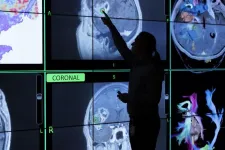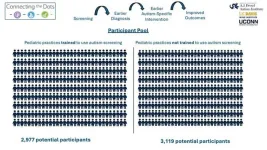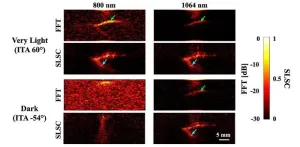(Press-News.org) A new variant of human mpox has claimed the lives of approximately 5% of people with reported infections in the Democratic Republic of the Congo since 2023, many of them children. Since then, it has spread to several other countries. The World Health Organization declared the outbreak a Public Health Emergency of International Concern on August 14. In addition, a different but rarely fatal mpox variant was responsible for an outbreak that has spread to more than 100 countries since 2022.
There is an urgent need for faster and more cost-effective diagnostic tools to curb the spread of mpox and to prepare for the possibility of a future global pandemic. Researchers from University of California School of Medicine, Boston University, and their colleagues have now developed an optical biosensor that can rapidly detect monkeypox, the virus that causes mpox. The technology could allow clinicians to diagnose the disease at the point of care rather than wait for lab results. The study was published on November 14, 2024 in Biosensors and Bioelectronics.
In the clinic, mpox symptoms such as fever, pain, rashes and lesions resemble those of many other viral infections, says Partha Ray, an associate project scientist at UC San Diego School of Medicine and co-principal investigator on the study. “So just by looking at the patient, it is not easy for clinicians to distinguish monkeypox from these other diseases.”
What’s more, polymerase chain reaction (PCR) is currently the only approved method of diagnosing mpox. It is expensive, requires a laboratory, and can take days or weeks to get results. “A deadly combination when there is a fast-spreading epidemic or pandemic,” said Ray.
The search for a better molecular diagnostic for mpox draws on more than 10 years of research in the lab of Selim Ünlü, a distinguished professor of engineering at Boston University (BU) and co-principal investigator on the study. The lab has developed optical biosensors for detecting the viruses that cause Ebola hemorrhagic fever and COVID-19, among others. Ray’s team at UC San Diego collaborated with Ünlü’s lab, providing biological expertise and authenticated samples to Ünlü’s engineering team.
The study, led by first author Mete Aslan, a Ph.D. student in electrical and electronics engineering at BU, used a digital detection platform called Pixel-Diversity interferometric reflectance imaging sensor, or PD-IRIS, to detect the virus.
The researchers used samples collected from the lesions of a patient at UC San Diego Health with laboratory-confirmed mpox. They briefly incubated the samples with monoclonal monkeypox antibodies provided by Ray’s lab that bind to proteins on the surface of the virus. The virus-antibody complex was then transferred into tiny chambers on the surface of silicon chips on the sensor that were treated to fix these nanoparticles.
Shining precise wavelengths of red and blue light simultaneously on the chips caused interference, which resulted in slightly different responses when the virus-antibody nanoparticles were present. A color camera was used to detect this small signal and count individual particles with high sensitivity.
“You're not trying to see the scattered light from the virus particle itself, but you're looking at the interferometric signature of the field of scattered light mixed with the field that is reflected from the surface of the chip,” said Ünlü. He likens the process to FM radio, which mixes a weak signal containing information with a more powerful carrier signal at the same frequency, which, in turn, amplifies the weak signal.
The scientists also analyzed herpes simplex virus and cowpox virus samples, which have similar clinical presentations to mpox. The biosensor assay easily discriminated mpox samples from these other viruses, demonstrating that the specificity of the assay is essential for distinguishing mpox from these common viral diseases.
“Within two minutes, we can tell whether someone has monkeypox or not,” said Ray. “From collecting the virus samples to getting the real-time data takes around 20 minutes.”
In the clinic, the rapidity of the test would allow healthcare providers to diagnose mpox cases much more quickly than sending samples out to a lab. This is especially important for slowing community spread in countries where healthcare resources are sparse. Clinicians could also start treatment, if available, more quickly.
Ray envisions the tests being mass-produced as kits and sold to clinics, further reducing costs. A single boxed kit could be used to test for a variety of viruses, such as syphilis or HIV.
“The chip would be the same,” said Ray. “The only thing that would be different here is the binding antibody that would be specific for a particular virus.”
Ray and Ünlü are working together toward the goal of commercialization, not only to address the urgent need for rapid mpox tests in the Democratic Republic of the Congo but also to keep outbreaks from turning into pandemics. However, the researchers say this effort will require government support because there is little market for diagnostics addressing future threats.
“If we don't take care of this particular epidemic right now, it is not going to be limited within Africa,” said Ray.
Additional co-authors on the study include: Howard Brickner, Alex E. Clark, Aaron F. Carlin, UC San Diego; Elif Seymour, iRiS Kinetics, Boston University Business Incubation Center; Michael B. Townsend, Panayampalli S. Satheshkumar, Centers for Disease Control and Prevention; Iris Celebi, Boston University; Megan Riley, axiVEND.
The study was funded, in part, by the National Institute of Allergy and Infectious Diseases at the National Institutes of Health (P30 AI036214), and the National Science Foundation (NSF-TT PFI 2329817).
# # #
END
Optical biosensor rapidly detects monkeypox virus
Technology could lead to fast and cost-effective diagnosis of mpox in the clinic.
2024-11-14
ELSE PRESS RELEASES FROM THIS DATE:
New drug targets for Alzheimer’s identified from cerebrospinal fluid
2024-11-14
A multitude of genes have been linked to the development of Alzheimer’s disease. Specifically how those genes might influence the progression of neurodegeneration remains something of a black box though, in part because of the challenges of examining in molecular detail the brain of a living patient.
Using cerebrospinal fluid (CSF) collected from living patients, a team of researchers at Washington University School of Medicine in St. Louis has for the first time linked disease-related proteins and genes to identify specific cellular pathways responsible for Alzheimer’s ...
Neuro-oncology experts reveal how to use AI to improve brain cancer diagnosis, monitoring, treatment
2024-11-14
INDIANAPOLIS — An international, multidisciplinary team of leading neuro-oncology researchers and clinicians has released new recommendations for good clinical practice — a set of guidelines that helps ensure clinical trial results are reliable, and patients are protected — regarding the use of artificial intelligence methods to more accurately diagnose, monitor and treat brain cancer patients.
The team recently published two companion policy reviews in The Lancet Oncology, on behalf of the ...
Argonne to explore novel ways to fight cancer and transform vaccine discovery with over $21 million from ARPA-H
2024-11-14
The U.S. Department of Energy’s (DOE) Argonne National Laboratory will use its world-leading capabilities in artificial intelligence (AI) and high performance computing to research novel ways to fight cancer and transform vaccine discovery.
The two awards, totaling up to $21.7 million, are from the Advanced Research Projects Agency for Health (ARPA-H), part of the U.S. Department of Health and Human Services. Established in 2022, ARPA-H’s mission is to accelerate transformative ...
Firefighters exposed to chemicals linked with breast cancer
2024-11-14
It’s well documented that firefighters have significantly higher rates of cancer than the general population, and these elevated rates have been associated with exposures to toxic chemicals on the job. However, most research on cancer in firefighters has been done in men and less is known about the risks in women.
Now a new study by Silent Spring Institute has identified multiple chemical exposures that firefighters face on the job that could increase their risk of developing breast cancer.
“With more and more women entering the profession, it’s important to understand the impact of workplace exposures on their health so that we can inform policies to reduce ...
Addressing the rural mental health crisis via telehealth
2024-11-14
The Medical University of South Carolina has been awarded $1.75 million from the Health Resources and Services Administration to develop and test the effectiveness and sustainability of the SC Rural Telehealth-enabled Collaborative Care Network (SC-RTECC). The SC-RTECC will deliver psychiatric collaborative care management to 1500 primary care patients over a five-year period in seven diverse, rural, underserved South Carolina counties.
The goal of the project is to test whether telehealth can be used to deliver psychiatric collaborative care management efficiently and sustainably at rural primary care clinics in South Carolina.
The project will be led by Ryan ...
Standardized autism screening during pediatric well visits identified more, younger children with high likelihood for autism diagnosis
2024-11-14
New research from Drexel University’s A.J. Drexel Autism Institute found that the use of standardized autism screening during pediatric well-child visits identifies more children with high autism likelihood at a younger age, including those presenting with more subtle symptoms. This is the first large-scale, randomized trial to test the impact of standardized autism screening on early detection of autism in pediatric primary care.
Recently published in the Journal of the American Academy of Child & Adolescent Psychology, the multi-site ...
Researchers shed light on skin tone bias in breast cancer imaging
2024-11-14
Breast cancer is a major health concern worldwide, and early detection is crucial for effective treatment. Traditional imaging methods, such as mammography, have limitations, especially for women with dense breast tissue. Photoacoustic imaging, which combines light and sound to create detailed images of breast tissue, offers a promising alternative. However, recent research has highlighted a significant challenge: skin tone bias.
A team of researchers from Johns Hopkins University recently investigated how skin tone affects the visibility of breast cancer targets in photoacoustic imaging. As reported in Biophotonics Discovery, the study focused on three image ...
Study finds humidity diminishes daytime cooling gains in urban green spaces
2024-11-14
Urban green spaces provide shade for city dwellers facing rising temperatures brought on by climate change, but how much relief from the heat island effect do they provide when humidity is factored in?
The temperature and humidity effect cancel each other out during daylight hours, but green spaces provide a net reduction in humid heat at night, according to a new study in Nature Cities, co-authored by Yale School of the Environment doctoral student Yichen Yang and Xuhui Lee, Sara Shallenberger Brown Professor of Climate Science.
"When it comes to urban ...
Tennessee RiverLine secures $500,000 Appalachian Regional Commission Grant for river experience planning and design standards
2024-11-14
The Tennessee RiverLine, an initiative of University of Tennessee Extension, has been awarded a $500,000 Area Development grant from the Appalachian Regional Commission (ARC) and Tennessee Department of Economic and Community Development to support the development of comprehensive Planning and Design Standards. These standards will help accelerate the creation of new river experience amenities along the 652-mile stretch of the Tennessee River, benefitting residents and visitors throughout the region.
The 18-month project will be led by a professional ...
AI tool ‘sees’ cancer gene signatures in biopsy images
2024-11-14
To determine the type and severity of a cancer, pathologists typically analyze thin slices of a tumor biopsy under a microscope. But to figure out what genomic changes are driving the tumor’s growth — information that can guide how it is treated — scientists must perform genetic sequencing of the RNA isolated from the tumor, a process that can take weeks and costs thousands of dollars.
Now, Stanford Medicine researchers have developed an artificial intelligence-powered computational program that can predict the activity of thousands of genes within tumor cells based only on standard microscopy images of the biopsy. The tool, described online in Nature Communications Nov. 14, ...
LAST 30 PRESS RELEASES:
Why nail-biting, procrastination and other self-sabotaging behaviors are rooted in survival instincts
Regional variations in mechanical properties of porcine leptomeninges
Artificial empathy in therapy and healthcare: advancements in interpersonal interaction technologies
Why some brains switch gears more efficiently than others
UVA’s Jundong Li wins ICDM’S 2025 Tao Li Award for data mining, machine learning
UVA’s low-power, high-performance computer power player Mircea Stan earns National Academy of Inventors fellowship
Not playing by the rules: USU researcher explores filamentous algae dynamics in rivers
Do our body clocks influence our risk of dementia?
Anthropologists offer new evidence of bipedalism in long-debated fossil discovery
Safer receipt paper from wood
Dosage-sensitive genes suggest no whole-genome duplications in ancestral angiosperm
First ancient human herpesvirus genomes document their deep history with humans
Why Some Bacteria Survive Antibiotics and How to Stop Them - New study reveals that bacteria can survive antibiotic treatment through two fundamentally different “shutdown modes”
UCLA study links scar healing to dangerous placenta condition
CHANGE-seq-BE finds off-target changes in the genome from base editors
The Journal of Nuclear Medicine Ahead-of-Print Tip Sheet: January 2, 2026
Delayed or absent first dose of measles, mumps, and rubella vaccination
Trends in US preterm birth rates by household income and race and ethnicity
Study identifies potential biomarker linked to progression and brain inflammation in multiple sclerosis
Many mothers in Norway do not show up for postnatal check-ups
Researchers want to find out why quick clay is so unstable
Superradiant spins show teamwork at the quantum scale
Cleveland Clinic Research links tumor bacteria to immunotherapy resistance in head and neck cancer
First Editorial of 2026: Resisting AI slop
Joint ground- and space-based observations reveal Saturn-mass rogue planet
Inheritable genetic variant offers protection against blood cancer risk and progression
Pigs settled Pacific islands alongside early human voyagers
A Coral reef’s daily pulse reshapes microbes in surrounding waters
EAST Tokamak experiments exceed plasma density limit, offering new approach to fusion ignition
Groundbreaking discovery reveals Africa’s oldest cremation pyre and complex ritual practices
[Press-News.org] Optical biosensor rapidly detects monkeypox virusTechnology could lead to fast and cost-effective diagnosis of mpox in the clinic.






